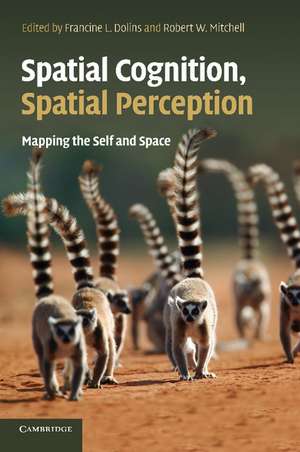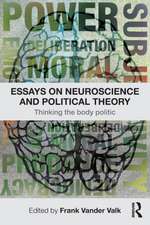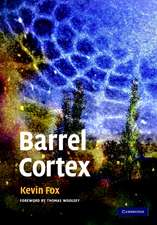Spatial Cognition, Spatial Perception: Mapping the Self and Space
Editat de Francine L. Dolins, Robert W. Mitchellen Limba Engleză Paperback – 30 iul 2014
| Toate formatele și edițiile | Preț | Express |
|---|---|---|
| Paperback (1) | 481.31 lei 6-8 săpt. | |
| Cambridge University Press – 30 iul 2014 | 481.31 lei 6-8 săpt. | |
| Hardback (1) | 782.89 lei 6-8 săpt. | |
| Cambridge University Press – 24 mar 2010 | 782.89 lei 6-8 săpt. |
Preț: 481.31 lei
Preț vechi: 540.80 lei
-11% Nou
Puncte Express: 722
Preț estimativ în valută:
92.10€ • 96.85$ • 76.10£
92.10€ • 96.85$ • 76.10£
Carte tipărită la comandă
Livrare economică 16-30 aprilie
Preluare comenzi: 021 569.72.76
Specificații
ISBN-13: 9781107646230
ISBN-10: 1107646235
Pagini: 606
Dimensiuni: 154 x 230 x 35 mm
Greutate: 0.8 kg
Editura: Cambridge University Press
Colecția Cambridge University Press
Locul publicării:New York, United States
ISBN-10: 1107646235
Pagini: 606
Dimensiuni: 154 x 230 x 35 mm
Greutate: 0.8 kg
Editura: Cambridge University Press
Colecția Cambridge University Press
Locul publicării:New York, United States
Cuprins
Introduction 1. Linking spatial cognition and spatial perception F. L. Dolins and R. W. Mitchell; Part I. What Do Animals Know and How Do They Represent External Space?: 2. Psychology and the philosophy of spatial perception: a history, or how the idea of spatial cognition in animals developed R. W. Mitchell and F. L. Dolins; 3. Common principles shared by spatial and other kinds of cognition K. Cheng; 4. To be buried in thought, lost in space or lost in action: is that the question? E. Menzel; Part II. Perception and Memory of Landmarks: Implications for Spatial Behaviour and Cognition: 5. The encoding of geometry in various vertebrate species C. Thinus-Blanc, V. Chabanne, L. Tommasi, P. Peruch and J. Vauclair; 6. The visually guided routes of ants T. Collett and P. Graham; 7. The role of landmarks in small and large scale navigation S. D. Healy and V. A. Braithwaite; 8. Examining spatial cognitive strategies in small-scale and large-scale space in tamarin monkeys P. A. Garber and F. L. Dolins; 9. Spatial learning and foraging in macaques C. Menzel; Part III. Evolutionary Perspectives of Cognitive Capacities in Spatial Perception and Object Recognition: 10. The evolution of human spatial cognition T. Wynn; 11. Egocentric and allocentric spatial learning in the nonhuman primate L. Rehbein, S. Schettler, R. Killiany and M. Moss; 12. Does the nature of cetacean perception make understanding object permanence unnecessary? R. W. Mitchell and E. Hoban; 13. Multimodal sensory integration and concurrent navigation strategies for spatial cognition in real and artificial organisms A. Arleo and L. Ronde-Reig; Part IV. Does Mapping of the Body Generate Understanding of External Space?: 14. Movement: the generative source of spatial perception and cognition M. Sheets-Johnstone; 15. Understanding the body: spatial perception and spatial cognition R. W. Mitchell; 16. The evolution of parietal areas involved in hand use in primates L. Krubitzer and E. Disbrow; 17. Body mapping and spatial transformations S. H. Creem-Regehr; 18. Understanding of external space generated by bodily re-mapping: an insight from the neurophysiology of tool-using monkeys A. Iriki; 19. Left-right spatial discrimination and the evolution of hemispheric specialization: some new thoughts on some old ideas W. D. Hopkins and C. Cantalupo; Part V. Comparisons of Human and Non-Human Primate Spatial Cognitive Abilities: 20. The geographical imagination R. Sambrook and D. Zurick; 21. Of chimps and children: use of spatial symbols by two species J. DeLoache and M. Bloom; 22. Chimpanzee spatial skills: a model for human performance on scale model tasks? S. Till Boysen and K. A. Bard; 23. The development of place learning in comparative perspective A. Learmonth and N. Newcombe; 24. Spatial cognition and memory in symbol-competent chimpanzees C. Menzel.
Recenzii
"A strength of this work, though, is its interdisciplinary focus. It approaches the topics from multiple theoretical orientations and methodologies. These include philosophy, history, evolution, anthropology, comparative psychology, cognitive psychology, and neuroscience. Investigators from each of these fields will find something of interest here. Spatial Cognition, Spatial Perception is worth getting and is a must read for any researcher in either of these areas. Due to its breadth of coverage, it serves more as a reference guide than as a single-themed or specialty area book, but any topic can be looked up in the index and compared across chapters if necessary."
Jay Friedenberg, PsycCRITIQUES
Jay Friedenberg, PsycCRITIQUES
Descriere
An analysis of human and non-human animals' spatial cognitive, perceptual, and behavioural processes through mapping internal and external spatial knowledge.









